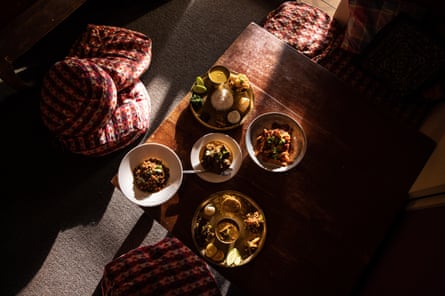
“How hot do you want the potato chilli?” asks the waiter. At Kathmandu Newa Chhe’n, a Nepalese restaurant in Brisbane, it comes mild, medium, and – ominously – “as hot as you like it”.
For the uninitiated, potato chilli (or chips chilli, as it’s also known) is a worthy competitor of poutine and the halal snack pack: potato chips fried to sticky decadence with a sweet-and-sour-like chilli sauce, and topped with onion, tomato, capsicum, garlic and coriander. Rarely seen on menus outside Nepal, it also comes in chicken, beef and buff (buffalo) versions. A better fried-carb snack might not exist.
Kathmandu Newa Chhe’n is located in a roomy Queenslander on a busy street corner of Paddington, in inner-city Brisbane, but the interiors evoke Nepal: low tables with traditional cushioned seating, a Nepali folk soundtrack, and mulberry and mustard hued rooms decked out with wood carvings, prayer flags and a small Hindu shrine. In Nepal meals are traditionally eaten with the right hand; there is a small wash basin out the back if you’d like to do so.
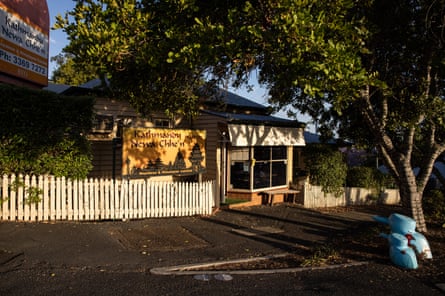
The restaurant’s name means “Kathmandu Newar House” and the menu specialises in Newari food from the Kathmandu Valley and Thakali cuisine from the mountainous Mustang district. Head chef Suresh Khadka started working in the kitchen when he came to Australia as a student 15 years ago; in 2011 Khadka and his cousin Niranjan Singh Thapa took over as co-owners, serving traditional food that catered to Brisbane’s growing Nepali community. (Those in the know will ask for the Nepali menu, which contains specialties not featured on the regular menu.)
Start with the sadeko: cold, crunchy mixtures that showcase the cuisine’s complex interplay of fresh flavours, peppery mustard oil and fiery chilli heat. The bhatmas sadeko is a tumble of soya beans, ginger, garlic, lime and coriander; the wai wai sadeko is a textural wonder of crushed instant noodles stirred through a mustard oil and lime-lashed blend of mung beans, roasted peanuts, red onion, tomato, cucumber, coriander and green chilli. It is criminally addictive.
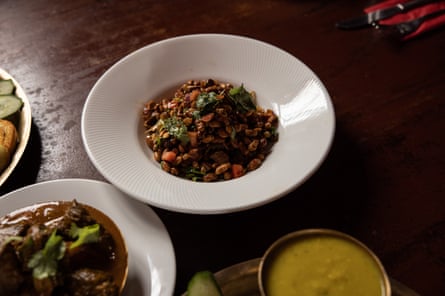
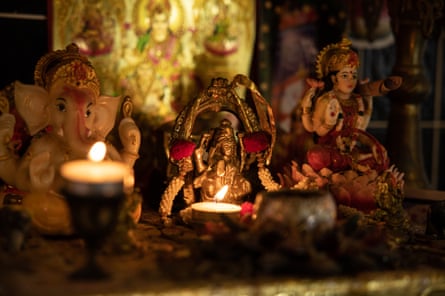
Nepal’s national dish is dal bhat tarkari, a meal built around the staples of rice (bhat), soupy lentils (dal) and vegetables (tarkari), and in Nepal is typically eaten twice a day. Depending on whether you order the vegetarian or omnivore versions, it may come with kauli mattar (cauliflower, potato and pea curry), masu (meat, traditionally chicken or goat), saag (cooked greens, in this case spinach), plus pickles, papad, yoghurt, a tomato chutney zinging with timur (a numbing spice similar to Sichuan pepper) and a tiny bowl of ghee to pour over the rice. It is comforting, homely and nourishing – a complete meal on a plate.
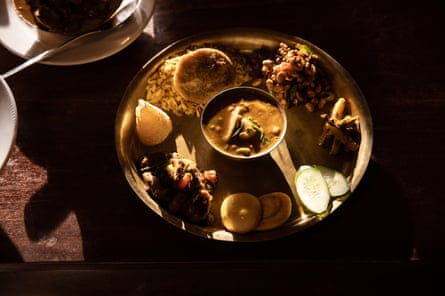
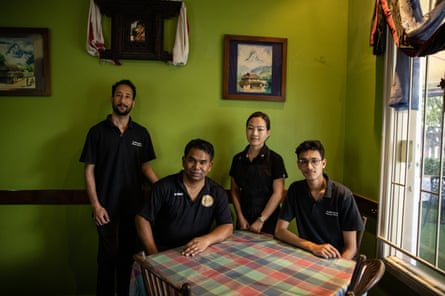
A signature Newari dish is the khaja set, served on a traditional brass platter. Often eaten at feasts, weddings and festivals (of which the Nepali calendar boasts more than 50 a year), the set features delicacies including cheura (chewy beaten rice); bodi tama (a soup of black-eyed peas, potato and bamboo); bhutan (crispy offal with chilli), choila (grilled meat); bhatmas sadheko, a fried boiled egg; and mula ko achaar, the pickled radish often seen fermenting in huge jars on rooftops and roadsides throughout Nepal.
The restaurant’s regional specialties are popular with the local Nepalese community, but Khadka says they have wider appeal: “We wanted to serve the food that Nepalis love, but found out that Aussies like it just as much” – whatever their preferred spice level.


